| MIATA BUILD |
|
|
 |  |  | January 19, 2008 - Time to weld the header together.
And learn how to TIG weld. Might as well pick something simple as a first project, right?
As I've mentioned before, the order of welding on this critter is going to be crucial. Luckily, the entire #4 runner can be welded together without causing problems for any others, which means I can use it to locate the collector. But since it was also the first runner I put together (without the help of a belt sander), the fitment of the tubes wasn't perfect. So I used the #3 runner to locate the collector, then reworked #4 to have a perfect fit. Naturally, this took a little time.
Then it was time to start working on my welding. It took surprisingly little time to come up to speed, although nobody's going to mistake my work for that of a professional. No matter, as long as it's airtight and strong I'll be happy.
Once the #4 runner was all welded up, I did a test fit of the header on the car. Whoops. The collector shifted, and my 1/4" of clearance to the block turned into about 1/4" of interference. That's not going to work. So the next step will be figuring out how to fix that. It'll involve at least one cut through the #4 runner along with a rotation, but the trick will be finding the magic place to do that without messing up the other three tubes. More fun to come, I'm sure.
In other news, Janel and I have signed up for the California Rally Series school in three weeks. We'll learn how to deal with the really tough part of rallying - the driver/codriver teamwork - and it'll help us get the necessary licenses for the race. Plus we get to spend a day in Las Vegas on the way!
entry 381 - tags: skills, header |  |  | January 21, 2008 - A single cut and twist on one of the tubes solved the interference problem with the collector.
Now, time to build the next runner. After some more grinding and massaging to make it fit with the final collector location, I welded it together. And almost screwed up in a big way!
After building the #3 runner, I tack-welded it to the flange - and was smart enough to test-fit the #2. Whoops! While welding the #3 runner, I removed a short spacer that I'd inserted. You can see it in the background of the last picture. I thought it had been put there to make the tube fit a bit better and my slightly reworked setup just improved the fit. But I'd forgotten it was also there to give enough room for the #2 tube to pass underneath! Also, if I kept going in the current order, I'd never be able to weld one of the #2 seams all the way around. So off came the tack weld and now I can assemble #2 without causing problems. That was close.
entry 382 - tags: header |  |  | January 21, 2008 - Welding welding welding.
Wow, there are a lot of seams in these pipes. And I'm going to have to add one more. It turns out there's no way I can attach #2 to the flange at the normal joint. So I'm going to have to cut it at a more convenient location so I can weld it back together again. The header's looking a little piecemeal up close, but from a distance it looks awesome. Lets hope it doesn't crack!
entry 383 - tags: header |  |  | 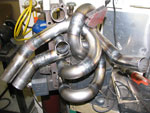 | January 22, 2008 - More welding.
And it's at the tricky stage now. In the picture I'm in the middle of welding the #3 runner to the flange, while the #2 runner is wrapped around it and held out of the way.
I have now finished all of the welds except one. But it's causing a problem. Not in terms of access, but a problem I didn't see coming. One of the tubes is stuck in the collector. Okay, that's not terribly serious. But I need to move it out about 1/8" so everything lines up perfectly. Without that I'm going to have to do some really ugly sectioning to make this work. I don't want to.
My TIG welding is definitely better, but conditions are getting more and more difficult as I go on so it's difficult to say just how well I'm doing. When I have nice access and a good joint, I can lay down a pretty bead. Most of them, however, are not.
entry 384 - tags: header |  |  |  | January 24, 2008 - And voila!
The finished item. Well, not really finished. I still have to put the tubing on between the collector and the rest of the exhaust and the flange needs to be sanded flat. But the hard part is done.
The stuck tube was freed by the application of lots of heat, a prybar, a hammer, a pair of pliers and two people. Thanks to Bill at Flyin' Miata for helping me out there. Once I could move it, I lined up the last seam and prepared to do the prettiest weld of them all. After all, this is the seam right on the top of the front tube, the most visible place. I carefully set everything up, went to weld...and BLAM! Blew a 1/4" hole in the tube. I'd forgotten to turn on the gas. So I called myself a few names, turned the gas on and filled the hole. So there's a big ugly goober weld there, nicely visible in this shot. Sigh.
entry 385 - tags: header |  |  | 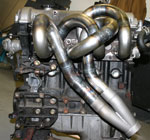 | January 24, 2008 - A side view of the finished setup.
This is going to be a little more difficult to see once it's all installed, of course. You can see on the lower welds on the #1 runner that I can actually lay down a decent bead sometimes. Most of the big goobers come from trying to hide the MIG tack welds. In hindsight, I should have ground them down once there was a bit of TIG bead. Why didn't I tack weld with the TIG? Because I can MIG with one hand and hold the pipes in place with the other.
entry 386 - tags: header |  |  | 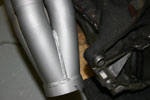 | January 24, 2008 - The clearance between the engine block and the collector.
It's nicely placed in there.
I've been trying to figure out how to finish the header. A coworker suggested ceramic coating and that would be ideal, but I'm not sure it's in the budget. I'll probably end up with high-temperature paint instead - at least until I know that 1) the header works and 2) it's not full of leaks.
entry 387 - tags: header |  |  | January 26, 2008 - There's a discussion of the header on the German MX-5 forum.
It's quite a long one and they bring up some good points - although I suspect it would be easier to read in German than through online translation engines! Some of the comments are ones I expected, particularly those about the welding quality. There were also questions about my choice to build such a convoluted design instead of a more traditional one with the collector down by the bellhousing, and how to prevent cracking. Since it's possible that others will be thinking along the same lines, here's what I replied to them. It provides a bit of a summation to the project so far:
I know some of the welding is ugly. I'm learning how to TIG weld on
this project. It was not easy. In some cases, I tried to hide my tack
welds (the little ones you make to hold everything in place) by
melting them down and spreading the material around. This makes the
weld look ugly, but it will look nicer when it's painted.
The tube length is chosen on musical principles. Basically, the high
pressure pulses from each cylinder will travel down the tube and
reflect back. At the right engine speed, this means you can get a low
pressure right on the exhaust valve which increases the suction and
makes more power. The tube length is determined by the cam profile and
desired engine speed. Tube diameter is a different question, although
you can cheat a bit and use a larger diameter and a slightly shorter
length for the same effect.
The Racing Beat header is surprising in a couple of ways. The tube
lengths are not all the same, which is a trick sometimes used to
spread the power band around a bit. But the short length is what's
odd. The header shouldn't work until it's up near 9000 rpm, and it
doesn't seem to improve as the engine spins faster. There may be some
secondary resonances that they're using. I did use larger diameter
tubing than the Racing Beat, but I didn't go to an extreme size. The
long tubes should give me more power in the medium to high engine
range, which is where I want it. They are almost all exactly the same
length.
The Boig headers don't fit well inside the car. They hit things, they
leak, they rattle and they bang around. I used one on my 1990 for a
short period of time. Even the Racing Beat has a dent in one of the
tubes to clear the steering column. So I decided to move my collector
high up to avoid the clearance problems. This is something that has
been used on other E Production race cars.
The english term for "glow in" is probably "heat treat" or "heat
cycle". I'll see how I can do that. I am concerned about longevity as
well.
But the biggest thing to remember is that I did this to learn. It was
ambitious, but now I'll know if it's better than the Racing Beat. I
have some room to adjust the length of the header (another advantage
of my collector location) so I can do some tuning if that helps. I've
learned a lot of about TIG welding. I don't present this as a lesson
on how to make a header, I'm giving people the chance to look over my
shoulder as I learn. I'll make mistakes. And I'll learn from them.
entry 388 - tags: header |  |  | 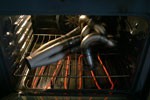 | January 26, 2008 - There was some concern on the German forum about the potential for cracking in the header - and rightfully so.
In an effort to avoid this, I'm heating the header up to 500F for a couple of hours, then I'll let it slowly cool down to room temperature. This should relieve any stresses in the tubing. Will it work? We'll see.
Yes, that's the kitchen stove. Now that Janel's the codriver for the car, she has less cause to complain. She was not overjoyed when I wanted to put car parts in the oven though. I did degrease it first!
entry 389 - tags: header |  |  | 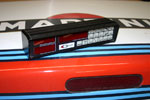 | January 26, 2008 - I made a comment a while back about accounting for the weight of the rally computer.
Well, it arrived from Eric a couple of days ago and there's not really a whole lot of grounds for concern. It's tiny! It's a Coralba C-Giant, although it's also quite possibly the least accurately named piece of electronics I've seen for a while.
entry 390 - tags: wiring, weight loss, computer |  |  |  | January 26, 2008 - A really slick plug.
When I removed the stock antenna from the car, there was a hole left in the rear fender. Not being a fan of bodywork, I didn't fill it before the big paint extravaganza. I altered the base of an antenna to sort of fill the hole, but it was ugly.
A coworker found this trick on one of the Miata forums, and it's brilliant. This plug is from the Miata windshield wipers. It hides the nut that attaches the wiper arms to the shaft. And it is the perfect size to plug the antenna hole. Very slick!
Update! Tom Smith informed me that Mazda provided a similar plug on the early base model Miatas that didn't come with a radio. Mazda Competition can provide them if you want the real thing.
Update #2! "Wreckerboy" found a similar plug at his local hardware store for around 18 cents.
entry 391 - tags: interchange |  |  |  | January 27, 2008 - I've been informed that heat treating usually takes place at 1000+ degrees, not 500.
And I've been told that my thin-walled pipes won't need it. And I've been told that the header will crack if I don't heat treat it, and that I can heat treat it in the oven. So many opinions!
I figure my home oven heat treating won't hurt anything, and maybe it'll help. Those who are concerned about the safety of my domestic arrangements will be glad to know that the header was not stinky. Remember, I did carefully degrease the part first!
The best part? Check out the cool colors! This picture doesn't do full justice to the neet brownish/purple sheen on the pipes.
entry 392 - tags: header |  |  | 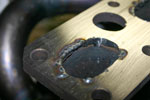 | January 31, 2008 - More header work.
Someday I'll have to move on to something else. But I spent some quality time with the belt sander ensuring the flange is nice and flat. Then I laid a gasket over the flange and did a little porting. In a few spots I needed a bit more material so I added it in with the welder. Now, more sanding then more grinding.
Once that's done, it's time to build the lower half and move on to something else!
In other news, I did install the navigator light provided by Rallylights.com and it will be wired in shortly. I'm also trying to figure out how to put in another door bar on each door. It's not going to make the cockpit any roomier, that's for sure.
entry 393 - tags: header, safety, ergonomics |  |  | February 4, 2008 - Big work this weekend - I wired up the navigator's light.
Ooo. Plus I went skiing in snow deep enough to drown me. But on a more serious note, we're in the middle of logistics. Hotel bookings, ferry bookings, airline bookings - and I have to figure out how to get to the car to the ferry. Such excitement! There's a lot to be done to simply show up at the starting line for this race.
entry 394 |  |  | 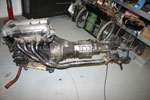 | February 4, 2008 - Time to finish off the header.
Step one is to make a jig. After all, a misalignment here will cause problems all the way down the exhaust system. So I mounted the Racing Beat header up on a spare engine and transmission, then bolted the flange from a stock midpipe to the end of the header. A quick and dirty bracket was welded on to this and bolted to the back of the transmission. Voila, a jig. Flyin' Miata actually has these for all the various Miata models, but nobody could find the 1999-05 one I needed.
entry 395 - tags: header |  |  | 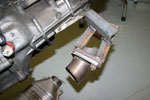 | February 4, 2008 - A junked catalytic converter supplied the flange for the header along with a nice little bend.
It's handy having extra exhaust pieces all over the place. Much of the rest of the header was built from a prototype turbo exhaust for a 2001 Protege5.
entry 396 - tags: header |  |  | 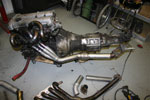 | February 4, 2008 - To do this properly I really should have the engine sitting on a subframe.
But, well, I don't. So I just took the Racing Beat routing as an example and tried to tuck the pipes in close to the transmission. It all went together extremely easily, actually.
I did put a flex joint in the middle of the pipe. I don't usually like to use them, but I figured a bit of flex might be appreciated by the spaghetti up top to decrease the risk of cracking a bit.
entry 397 - tags: header |  |  |  | February 4, 2008 - Another hour or so of playing with pools of molten metal and the header is welded up.
As you can see, my TIG welding has improved quite a bit! This section of the pipe does have the proper curve to it, don't worry. It looks a little kinked in this picture.
So, does it fit in the car? One small problem. That flex joint is in just the perfect place to hang up on the bellhousing as I insert the header into the car. It's a fraction of an inch too large to fit through. By loosening up the nut on one motor mount and sticking a jack under the oil pan, I was able to shift the engine slightly to let it past. Once that's done, it's perfect. Almost like it was meant to be in there!
All that remains to be done is to locate and weld in a bung for the O2 sensor. Then I'll bolt it all up and we'll see if it's airtight. I don't feel like crawling under the car to mark the O2 location tonight so it'll be in a day or two. There's not a huge rush as I can't drive the car until my differential shows up and I can wrest the AFCOs from the car they're in.
entry 398 - tags: header |  |  |  | February 6, 2008 - The final step in the header.
Provided it doesn't crack or cause problems later, of course! I marked the ideal location for the oxygen sensor when it was installed in the car, and then drilled a hole and welded on this fitting. Goofy thing, it was basically a big nut. Well, welding a flat nut on to a curved pipe means lots of filling in. I did an okay job, but I would have preferred to have one of the better-made units that is machined to insert into the hole. It involves less gaping space.
Oh well, it's on now so I can install the unit. I still have to get my hands on the (final) differential, so the rest of the exhaust can't go together until then. The final spec of the shocks was sorted out today - the front body will be 1" shorter with a different upper mount on the production versions to fit the 1999+ cars better - so I should have those back soon. Just in time for the track testing on March 9th, of course.
entry 399 - tags: header |  |  | February 11, 2008 - Rally school!
Janel and I travelled to Ridgecrest, California for the California Rally Series school on Saturday. This allows us to earn NASA Rally licenses for the Targa as well as teaching us, well, how to be a rally team.
The school's been on for around 12 years or so, and most of the bugs have been worked out. The day started off with a lot of classroom work, covering the basics such as classification, license types and how the heck to get involved. Then we moved on to basic timing and scoring - including a little rally run around the hotel. This is the area that Janel and I really need practice on, and it gave us a good idea of what to expect.
The section on course following and safety was unfortunately given by someone unfamiliar with the material, and she ran over time so some of the most useful sections were glossed over very quickly. We'll go back and spend some time with the workbook that was given to each of us. Still, it gave both Janel and I an idea of how the in-car interaction will work. That's the part we need to practice the most.
Around 2:30, the class split up. The drivers headed for a rallycross course. Now, I'm going to be racing a rear wheel drive 5-speed Miata on tarmac roads with racing tires. So the obvious way to practice for that is by driving a front wheel drive automatic family sedan in mud, isn't it? Okay, maybe not. And maybe I didn't pick up a lot of useful tips in the driving practice because of it and because I have more experience behind the wheel in extremis than some of my classmates. But I did have a lot of fun, and I can definitely not recommend you buy a used rental car. You might get mine.
Meanwhile, as I was throwing mud onto the roof of our respectable sedan and left-foot braking until the car reeked of cooking brake pad, Janel was working hard. She has a good idea now of just how much preparation she's going to have to do each night during the rally. Codriving isn't just about being a lump of ballast as some nutcase tries to get you both killed, it's about preparation and being able to juggle dozens of inputs under fairly stressful conditions. And that's the sort of thing that she does very well. While she's not excited about the amount of work that will have to be done during the event, she's now asking the sort of questions I love to hear - questions about regulations, timing controls and the capabilities of our rally computer. She was disappointed in her practical training during the school, but she's got what she needs to get started. Being a rally fan helped out a lot and she knows a lot more about driving than her classmates.
Overall, a decent school. Both of us would have preferred a higher level of instruction - perhaps by splitting the two groups apart earlier in the day - but we now know enough to learn the rest on our own. If we can find a TSD in our area, that would be ideal.
entry 400 - tags: skills |  |  |
|

 THE DIARY
THE DIARY